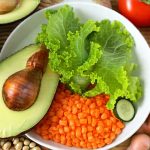Understanding how our bodies process food is fundamental to optimizing energy levels, managing weight, and supporting overall well-being. Often overlooked in dietary discussions is the rate at which different foods are digested – a crucial factor impacting everything from post-meal alertness to long-term metabolic health. The concept of fast-digesting versus slow-digesting foods isn’t about inherent “good” or “bad” choices, but rather recognizing how varying digestion speeds affect our bodies differently and leveraging that knowledge for more effective meal planning. It’s about aligning food choices with individual needs and activity levels, not subscribing to restrictive diet trends.
This distinction is deeply tied to the macronutrient composition of foods – carbohydrates, proteins, and fats – as well as their fiber content and processing level. Simple sugars and refined carbohydrates tend to digest quickly, causing rapid spikes in blood glucose, while complex carbohydrates, protein, and healthy fats take longer to break down, resulting in a more gradual release of energy. Ignoring these differences can lead to energy crashes, cravings, and ultimately hinder our ability to sustain consistent health habits. Effective meal planning considers both the what and the how quickly of food digestion to create a balanced and nourishing dietary approach.
The Science Behind Digestion Rates
The speed at which we digest food is influenced by several key factors. Carbohydrates are generally broken down most rapidly, followed by proteins, and then fats. However, this isn’t a universal rule; the type of carbohydrate significantly impacts digestion time. Simple sugars (like those found in candy or soda) are quickly absorbed into the bloodstream, leading to a rapid glucose spike. Complex carbohydrates (found in whole grains, vegetables, and legumes) contain fiber which slows down digestion, promoting a more sustained release of energy. Similarly, fats delay gastric emptying – the rate at which food leaves the stomach – contributing to prolonged satiety.
- Fiber content plays a pivotal role: high-fiber foods require more chewing and take longer for enzymes to break down.
- Food processing also matters: refined grains have had their fiber removed, making them faster digesting than whole grains.
- Individual metabolic rates and gut microbiome composition can further influence digestion speeds.
Understanding the Glycemic Index (GI) and Glycemic Load (GL) provides a useful framework for assessing how different foods affect blood sugar levels. While GI measures how quickly a food raises blood glucose, GL considers both the GI and the amount of carbohydrate in a serving. Choosing foods with lower GI and GL values can help stabilize blood sugar and prevent energy fluctuations. Prioritizing whole, unprocessed foods is generally a reliable strategy for promoting slower digestion. Individuals who experience nausea might also find relief by considering foods that trigger bloating and adjusting their diet accordingly.
Practical Applications In Meal Planning
Integrating fast-digesting and slow-digesting foods into meal planning isn’t about eliminating one or the other; it’s about strategically using them to support your lifestyle and goals. For instance, athletes may benefit from faster-digesting carbohydrates before, during, or immediately after intense exercise to replenish glycogen stores and provide quick energy. Conversely, individuals aiming for sustained energy throughout the day might prioritize slow-digesting foods in their breakfast and lunch to avoid mid-afternoon slumps.
A balanced meal should ideally include a combination of macronutrients – carbohydrates, proteins, and fats – alongside fiber. This ensures a more consistent release of energy and prevents drastic blood sugar spikes or drops. Consider these examples:
* A breakfast of oatmeal with berries (slow-digesting carbs), nuts (healthy fats), and Greek yogurt (protein) provides sustained energy.
* A snack of an apple with peanut butter combines fast-digesting carbohydrates from the apple with slow-digesting protein and fat from the peanut butter.
* Pairing a lean protein source (like chicken or fish) with complex carbohydrates (like quinoa or sweet potatoes) and vegetables creates a well-rounded, balanced meal. The goal is to create meals that support stable energy levels and promote satiety. A key aspect of this balance can also be found in low-fermentation foods which are easier on the digestive system.
Optimizing Pre- And Post-Workout Nutrition
Nutrition around exercise is where the distinction between fast-digesting and slow-digesting foods becomes particularly relevant. Pre-workout nutrition should focus on providing readily available energy for optimal performance. This typically involves faster-digesting carbohydrates – such as a banana, a small bowl of oatmeal, or a sports drink – consumed 30-60 minutes before exercise. These quickly provide glucose to fuel muscles. However, it’s important to avoid excessive amounts that might cause digestive discomfort during activity.
Post-workout nutrition aims to replenish glycogen stores and repair muscle tissue. A combination of faster-digesting carbohydrates and protein is ideal within 30-60 minutes after exercise. This allows for rapid glucose uptake by muscles, combined with amino acids from protein to initiate muscle recovery. Examples include a protein shake with fruit, or chicken breast with sweet potato. The timing is crucial; the “window” of opportunity for optimal nutrient absorption is generally considered to be within a couple of hours post-exercise. It’s important to remember the connection between inactivity and digestive issues, making regular exercise even more beneficial.
Managing Blood Sugar And Energy Levels
For individuals managing blood sugar levels – including those with diabetes or insulin resistance – prioritizing slow-digesting foods is paramount. These foods help prevent rapid spikes in glucose, reducing the burden on the pancreas and improving overall metabolic control. Incorporating high-fiber carbohydrates like whole grains, legumes, and non-starchy vegetables into meals can significantly improve blood sugar stability.
Combining carbohydrates with protein and healthy fats further slows down digestion and reduces glycemic impact. For example, instead of eating a piece of fruit on its own, pair it with a handful of nuts or a dollop of Greek yogurt. Consistent meal timing and portion control are also essential components of blood sugar management. Avoiding processed foods, sugary drinks, and refined carbohydrates is crucial for maintaining stable energy levels throughout the day. Understanding food and mood can provide additional insights into dietary choices.
Building Balanced Meals For Sustained Satiety
Creating meals that promote sustained satiety – feeling full and satisfied after eating – relies on incorporating slow-digesting foods and prioritizing nutrient density. Protein and healthy fats are particularly effective at promoting fullness due to their slower digestion rates. Including a source of protein in every meal is a good starting point.
Fiber also plays a significant role; high-fiber foods expand in the stomach, sending signals to the brain that promote feelings of fullness. Building meals around whole, unprocessed foods – such as lean proteins, complex carbohydrates, healthy fats, and plenty of vegetables – not only provides essential nutrients but also supports long-term health and weight management. Remember, mindful eating practices—paying attention to hunger cues and savoring your food—complement dietary choices in achieving lasting satiety. For older adults, managing chronic nausea is crucial for maintaining a healthy diet and quality of life, often requiring adjustments to food choices. Furthermore, understanding why carbonated drinks worsen indigestion can help individuals make informed decisions about their beverage consumption.


















